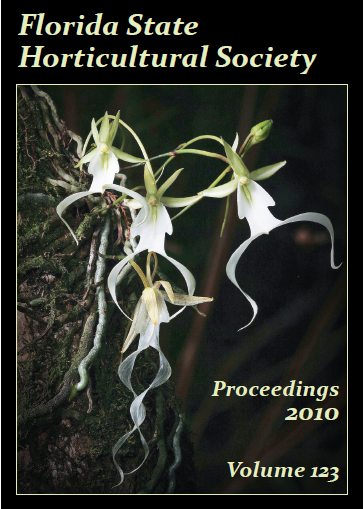Ornamental, Garden & Landscape
Abstract
Inappropriate use of fertilizers in urban environments has been implicated in increased nutrient loads in Florida water bodies. We tested how accurately lawn fertilizers were applied by 36 master gardeners and other volunteers. Subjects were asked to apply a label rate of fertilizer [30% fine granular slow-release formulation (32–0–10) at 1.37 kg/100 m2 (2.81 lb/1000 sq ft) and a coarse granular readily available nitrogen fertilizer (10–0–10) at 3.17 kg/100 m2 (6.5 lb/1000 sq ft)] using three spreaders [a hand-held rotary, a broadcast rotary (push), and a drop spreader]. Results showed that under the test conditions applications using the hand-held rotary spreader were the most accurate (averaging 98% of target rate over two tests), while applications using the push rotary spreader tended to be over-applied (138% to 301% of target rate), and those of a drop spreader tended to be under-applied (31% to 48% of target rate). Our simple study highlights that lawn fertilizers are not always accurately applied. Sources of error included variability in applicator walking speed, inaccurate swath widths (e.g., too narrow with push rotary or too wide with drop spreader), and the amount of fertilizer loaded into hoppers. A good approach to provide a quick check of overuse or underuse is for applicators to determine the area to be treated and calculate and weigh the required amount of fertilizer before application. The inclusion of a volumetric measurement on the bag label (in addition to weight) would facilitate calibration for homeowners without requiring access to weigh scales.References
- Anderson, D.M., P.M. Gilbert, and J.M. Burkholder. 2002. Harmful algal blooms and eutrophication: Nutrient sources, composition, and consequences. Estuaries 25:704–726.
- Bierman, P.M., B.P. Horgan, C.J. Rosen, A.B. Hollman, and P.H. Pagliari. 2010. Phosphorus runoff from turfgrass as affected by phosphorus fertilization and clipping management. J. Environ. Qual. 39:282–292.
- Easton, Z.M., P. Gerard-Marchant, M.T. Walter, A.M. Petrovic, and T.S. Steenhuis. 2007. Identifying dissolved phosphorus source areas and predicting transport from an urban watershed using distributed hydrologic modeling. Water Resour. Res. 43:W11414, doi:10.1029/2006WR005697.
- Erickson, J.E., J.L. Cisar, G.H. Snyder, D.M. Park, and K.E. Williams. 2008. Does a mixed-species landscape reduce inorganic-nitrogen leaching compared to a conventional St. Augustinegrass lawn? Crop. Sci. 48:1586–1594.
- Erickson, J.E., J.C. Volin, J.L. Cisar, G.H. Snyder. 1999. A facility for documenting the effect of urban landscape type on fertilizer nitrogen runoff. Proc. Fla. State Hort. Soc. 112:266–269.
- Florida Department of Environmental Protection. 2009. Florida-friendly landscape guidance models for ordinances, covenants, and restrictions. FDEP and the University of Florida. <http://www.dep.state.fl.us/water/nonpoint/pubs.htm>.
- Hochmuth, G., T. Nell, J. Sartain, B. Unruh., M. Dukes, C. Martinez, L. Trenholm, and J. Cisar 2009. Unintended consequences associated with certain urban fertilizer ordinances. Fla. Coop. Ext. Serv. IFAS. EDIS Publ. No. SL 283. <http://edis.ifas.ufl.edu/pdffiles/SS/SS49600.pdf>.
- King, K.W., J.C. Balogh, and R.D. Harmel. 2007. Nutrient flux in storm water runoff and baseflow from managed turf. Environ. Pollut. 150:321–328.
- Lehman, J.T., D.W. Bell, and K.E. McDonald. 2009 Reduced river phosphorus following implementation of a lawn fertilizer ordinance. Lake Reserv. Mgt. 25:307–312
- Parish, R.L. 2001. Technical notes: Effects of coating thickness on spreader damage to encapsulated controlled-release fertilizer granules. Appl. Eng. Agr. 17:459–460.

